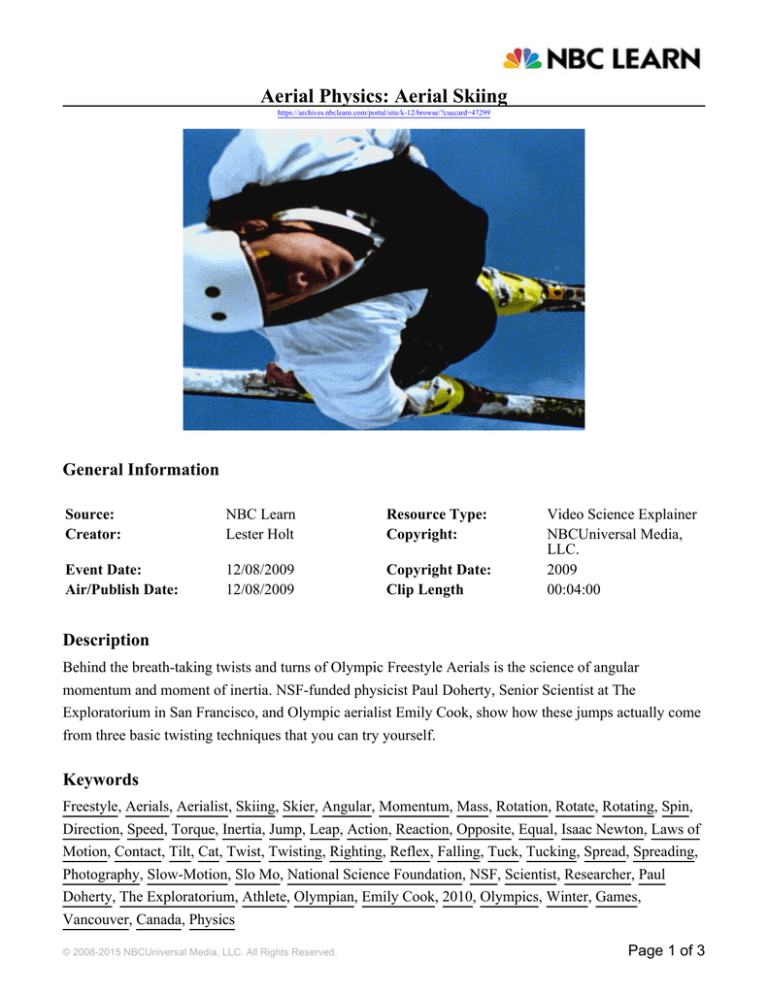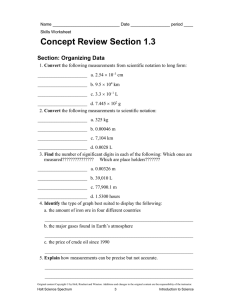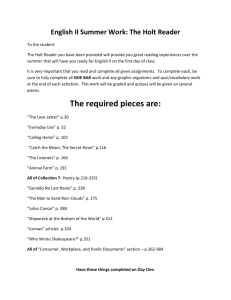
Aerial Physics: Aerial Skiing
https://archives.nbclearn.com/portal/site/k-12/browse/?cuecard=47299
General Information
Source:
Creator:
NBC Learn
Lester Holt
Resource Type:
Copyright:
Event Date:
Air/Publish Date:
12/08/2009
12/08/2009
Copyright Date:
Clip Length
Video Science Explainer
NBCUniversal Media,
LLC.
2009
00:04:00
Description
Behind the breath-taking twists and turns of Olympic Freestyle Aerials is the science of angular
momentum and moment of inertia. NSF-funded physicist Paul Doherty, Senior Scientist at The
Exploratorium in San Francisco, and Olympic aerialist Emily Cook, show how these jumps actually come
from three basic twisting techniques that you can try yourself.
Keywords
Freestyle, Aerials, Aerialist, Skiing, Skier, Angular, Momentum, Mass, Rotation, Rotate, Rotating, Spin,
Direction, Speed, Torque, Inertia, Jump, Leap, Action, Reaction, Opposite, Equal, Isaac Newton, Laws of
Motion, Contact, Tilt, Cat, Twist, Twisting, Righting, Reflex, Falling, Tuck, Tucking, Spread, Spreading,
Photography, Slow-Motion, Slo Mo, National Science Foundation, NSF, Scientist, Researcher, Paul
Doherty, The Exploratorium, Athlete, Olympian, Emily Cook, 2010, Olympics, Winter, Games,
Vancouver, Canada, Physics
© 2008-2015 NBCUniversal Media, LLC. All Rights Reserved.
Page 1 of 3
Citation
MLA
"Aerial Physics: Aerial Skiing." Lester Holt, correspondent. NBC Learn. NBCUniversal Media. 8 Dec.
2009. NBC Learn. Web. 21 November 2015
APA
Holt, L. (Reporter). 2009, December 8. Aerial Physics: Aerial Skiing. [Television series episode]. NBC
Learn. Retrieved from https://archives.nbclearn.com/portal/site/k-12/browse/?cuecard=47299
CHICAGO MANUAL OF STYLE
"Aerial Physics: Aerial Skiing" NBC Learn, New York, NY: NBC Universal, 12/08/2009. Accessed Sat
Nov 21 2015 from NBC Learn: https://archives.nbclearn.com/portal/site/k-12/browse/?cuecard=47299
Transcript
Aerial Physics: Aerial Skiing
LESTER HOLT, anchor:
In the sport of Freestyle Aerials, skiers are judged on their ability to perform complex jumps in the air.
Emily Cook, a 12-year veteran of the U.S. Freestyle team, and The Exploratorium’s Paul Doherty, a
physicist funded by the National Science Foundation, show how these jumps actually come from three
basic twisting techniques that you can try yourself.
HOLT: It's a sport of seemingly endless twists and turns. In Olympic Freestyle Aerials, skiers plummet
down a steep ramp at up to 45-miles an hour before launching almost 50-feet into the air.
Then the real fun begins. Olympic Aerialist Emily Cook is part acrobat, part daredevil -- and an intuitive
master of physics.
EMILY COOK (U.S. Ski Team – Freestyle): I think I was kind of born to be upside down. Some people
are like that. It’s my most comfortable position.
HOLT: Any rotating mass has a property known in physics as angular momentum... created when torque a force causing a free body to rotate - is applied to a mass, in this case an aerialist. Aerial skiers call this
"contact twisting," and they create it in the way they push off the ramp.
COOK: If you were standing on the ground and you were to just jump up and do a full twist, your pushing
off of the ground is what is causing the twist.
HOLT: Paul Doherty, Senior Scientist at The Exploratorium in San Francisco, shows how you can do
“contact twisting” yourself.
Dr. PAUL DOHERTY (The Exploratorium): Watch me, I’ll leap into the air and turn 90 degrees by
pushing on the ground before I leap. That was easy!
HOLT: The push-off is crucial: once in the air, aerialists cannot change their angular momentum. So how
© 2008-2015 NBCUniversal Media, LLC. All Rights Reserved.
Page 2 of 3
do they control their motion to execute the best spin in the air?
By controlling what's called their "moment of inertia" - which they do by moving their arms and legs in
and out. A good illustration of this comes from the animal kingdom.
Cat: Meow!
HOLT: For more than a century, scientists have studied why a falling cat almost always lands on its feet.
Slow-motion photography reveals that by tucking its front legs and spreading its back ones -- all while
rotating the upper and lower torso in opposite directions -- the cat can twist without touching anything.
Dr. DOHERTY: One part of the cat is turning one way and the other part’s turning the other. By changing
the position of the mass, they can actually turn in the air.
HOLT: Aerialists perform the "cat twist" by making a hula-hoop motion with their hips.
COOK: If you picture yourself in a pool and you bend yourself at your waist, and you just kind of swivel
yourself around, eventually you’ll start twisting.
HOLT: The last technique, called "tilt-twisting," uses precise arm movements to alter the speed and
orientation of the spin.
COOK: If I were to go off the jump, I have both of my arms up, and if I were to drop my left arm, if you
think about every action has an equal and opposite reaction, my body is going to go the other way.
Dr. DOHERTY: If I start out with my arms like this, I’m going to rotate my arms, right one back and left
one forward. Watch that happens to my legs, and that was very effective in turning me.
HOLT: On the ground, twisting may look easy. But six stories above the ground -- with the whole world
watching -- Olympic Freestyle Aerials is nothing less than a leap of faith in the laws of physics.
© 2008-2015 NBCUniversal Media, LLC. All Rights Reserved.
Page 3 of 3




